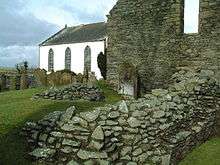Whithorn
| Whithorn | |
 Whithorn |
|
| Population | 867 (2001 Census) |
|---|---|
| OS grid reference | NX445405 |
| Council area | Dumfries and Galloway |
| Lieutenancy area | Wigtown |
| Country | Scotland |
| Sovereign state | United Kingdom |
| Post town | NEWTON STEWART |
| Postcode district | DG8 |
| Dialling code | 01988 |
| Police | Scottish |
| Fire | Scottish |
| Ambulance | Scottish |
| EU Parliament | Scotland |
| UK Parliament | Dumfries and Galloway |
| Scottish Parliament | Galloway and West Dumfries |
Coordinates: 54°44′06″N 4°24′58″W / 54.735°N 4.416°W
Whithorn (Taigh Mhàrtainn in Gaelic) is a former royal burgh in Dumfries and Galloway, Scotland, about ten miles south of Wigtown.[1] The town was the location of the first recorded Christian church in Scotland, Candida Casa : the 'White [or 'Shining'] House', built by Saint Ninian about 397.
Toponymy
Whithorn was first known (in Latin) as Candida Casa. 'Whithorn' is a modern form of the Anglo-Saxon version of this name, Hwit Ærn, 'white house'. In Gallovidian Gaelic, it was called Rosnat, or Futarna, the latter a version of the Anglo-Saxon name (Gaelic has no sound corresponding to English 'wh').[2]
Eighth and twelfth centuries
A monastery and diocese of the Anglo-Saxon kingdom of Northumbria was founded on the site in the 8th century. It was the centre of the revived See of Galloway (or Candida Casa) under the patronage of Fergus, Lord of Galloway and Bishop Gille Aldan from the 12th century. The late-medieval cathedral Whithorn Priory is ruinous, much of it having disappeared completely apart from the much-altered aisleless nave and vaults at the former eastern end which once held the shrine of St. Ninian, one of medieval Scotland's major pilgrimage destinations. A museum in the town contains finds from the site, which has been extensively excavated in recent years. A late-medieval gateway with the arms of the King of Scots leads into the site of the priory, which contains the 19th-century parish church and a museum of carved stones (Historic Scotland). The collection of early medieval stones is one of the largest in Scotland, and includes the country's earliest surviving Christian memorial, the 5th-century inscribed 'Latinus Stone'. The museum layout and display was revised and greatly improved in 2005.
The crozier
One of the finest artefacts found at the site is the Whithorn crozier. The gilded and enamelled crozier is an outstanding example of champlevé enamels which were being made in England in the second half of the 12th century, and this one dates to around 1175.[3] It is now housed in the National Museums of Scotland, although it is loaned to the Whithorn Trust Visitor Centre every summer. It is thought that the crozier was buried with the body of Simon de Wedale, who was one of the Bishops of Whithorn.
Geography
Whithorn's link to the sea was the port known as the Isle of Whithorn (a separate community from Whithorn itself and actually a peninsula). Much used in the Middle Ages by pilgrims arriving by boat. The thirteenth century St Ninian's Chapel marked the point where pilgrims came ashore (the roofless remains are looked after by Historic Scotland).
The 1st century settlement of Rispain Camp, about 1 mile west of Whithorn is also in the care of Historic Scotland.
Railway
Whithorn was once served by a railway station until 1950 when the passenger service was withdrawn and the freight services falling victim to the Beeching axe in 1964. The track was lifted in April 1965. <refhttps://www.railscot.co.uk/imageenlarge/photographer.php?loc=Frank%20Spaven%20Collection%20(Courtesy%20David%20Spaven)&img=27486/ref>
List of Listed Buildings
List of listed buildings in Whithorn, Dumfries and Galloway
Gallery
 Seal of the Burgh of Whithorn
Seal of the Burgh of Whithorn
 Remains of the Priory Nave at Whithorn
Remains of the Priory Nave at Whithorn- The Monreith Cross in the Whithorn Museum
See also
Notes and references
- ↑ "Whithorn", Royal Burgh of Whithorn and District Business Association
- ↑ Thomas, Charles (1971) “Topographical Notes. - 3 : Rosnat, Rostat, and the Early Irish Church” In: Ériu, Vol.xxii, 1971
- ↑ Glenn, Romanesque and Gothic, pp. 29-33.
- Glenn, V. (2003) Romanesque and Gothic: decorative metalwork and ivory carvings in the Museum of Scotland, Edinburgh: Museum
| Wikimedia Commons has media related to Whithorn. |
External links
| Wikiquote has quotations related to: Whithorn |
- http://www.aocarchaeology.com/machars/
- http://commons.wikimedia.org/wiki/Category:Whithorn_Priory
- https://archive.org/stream/castellateddomes05macguoft#page/249/mode/1up Castlewigg Tower plan
- https://archive.org/stream/castellateddomes05macguoft#page/354/mode/1up Isle of Whithorn Castle
- The Whithorn Trust
- http://www.whithorn.info/
- http://www.whithornevergreens.co.uk/